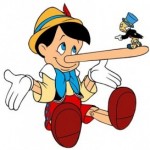In public relations and corporate affairs we talk a lot about ‘honesty’. But the term is used, well, flexibly. There are, for instance, ‘white lies’ and ‘core and non-core election promises’.
The HBR blog below desribes a study that considers the impact of honesty amongst the leadership on employees. Can we extrapolate? And what is the possible impact of social media?
Here are two thoughts:
1. Our politicians define our behaviour. We ‘learn’ from watching them on nightly television. A political system where broken promises and fundamental dishonesty is the excepted norm impacts on everyone. For instance business leaders will think “Why should I deal honestly with the government, if the government doesn’t see it as a priority?”. In Australia it’s a serious leadership issue.
2. Social media may in the future be the great normaliser, as white lies get outed. We can’t run, we can’t hide.
The Data’s In: Honesty Really Does Start at the Top: (HBR Blog Network)
12:21 PM Friday June 1, 2012 : by Jack Zenger and Joseph Folkman
 It’s hard to reach the 90th percentile in anything, of course, and honesty is no different. So when we ran across one of those exceptional individuals, we wanted to have a word with him.
It’s hard to reach the 90th percentile in anything, of course, and honesty is no different. So when we ran across one of those exceptional individuals, we wanted to have a word with him.
A global controller of a professional services firm of more than 40,000 employees, he’d just participated in a 360-feedback process where he’d been assessed by his manager, peers, and direct reports on 16 leadership competencies. And he’d hit that elusive 90th percentile mark on his ratings for honesty and integrity. Explaining just what a difficult feat it is to receive feedback marks that remarkably high, we asked him: “What is your secret?” After all, it’s not like in his role he hadn’t confronted his share of temptation or hard trade-offs.
“It all starts with my boss and his boss,” he replied. “If there is a line for honesty and integrity, they don’t want to be close to it. Instead, they insist there be nothing questionable with any transaction. If there is a liberal interpretation of an accounting principle, they will always take the conservative route. It’s never hard for me to insist on unquestionable honesty, because they set the bar.”
To understand the impact top managers have on ethics and honesty, we looked at the data we’d collected from 5,268 leaders in five different organizations. The data identified each leader by level (e.g., top management, middle management, lower level management). The graph below shows the average of all leaders, along with the highest- and the lowest-rated organizations. In all three organizations, the rating decreases at every level as you move down the management chain.
These data appear to be very consistent with our global controller’s experience. What’s more, they are consistent with all of our data. Generally speaking, in our long years of collecting 360 responses, we have found the top managers in an organization create a ceiling — that is, leaders the next level down tend to be rated lower than their managers on every leadership dimension — and that includes their honesty and integrity. In other words, levels of honesty are set at the top and can only go downhill from there.
In our best-performing organization, that ceiling was at the 97th percentile (which as we say was fairly rare). In the lowest-performing organization, it was at the 66th percentile. This research is consistent with broader findings we discuss in our forthcoming book How to Be Exceptional.
Organizations should take this finding very seriously. While we’d never suggest this pattern holds at every organization, we also doubt that all of the companies in this study are the exception, either: Top level leaders would do well to assume that integrity erodes as you move deeper into the organization.
But why should this be? We believe our 360 data may shed some light on this as well. In a 360, of course, individuals are rated by their manager, their peers, their direct reports, and other colleagues. Most people would expect the rater who evaluates honesty and integrity the toughest would be the subject’s manager. But in reality, managers tend to give their direct reports higher marks for honesty and integrity than those individuals get from their peers — and than they give themselves.
In other words, managers consistently overrate their direct reports’ honesty and integrity. And (as you can see from the graph) the more effective an individual is as a leader, the worse this gets. So just as being honest matters more and more, individuals are given more and more of the benefit of the doubt.
In a working culture that is increasingly dependent on honesty and integrity (and where organizations face increasingly high consequences when integrity fails), managers should take several important messages away from this research.
Knowing that managers tend to assume greater levels of integrity in their direct reports than the workers do themselves, they should not take honesty as a given. Nor should they assume that effectiveness and honesty go hand-in-glove. They should instead take deliberate care to communicate expectations of honesty. They should put stronger structures in place to require and enforce the level of integrity they want to protect and assume is in place. They should take a good look at their own integrity and honesty standards and consider how well those standards are communicated and made evident to their teams.
As leaders move up, the dangers, and their consequences multiply. Many of the checks and balances that surrounded them disappear. They have access to more discretionary funds. Subordinates are less prone to speak up or criticize any action. The time horizon of decisions is extended, so consequences are not immediately seen. There is stronger and stronger pressure to deliver results to meet others’ expectations, which in turn gives rise to the “35 day month” for recording sales.
Senior leaders need to warn those coming into such roles that they are entering a dangerous territory — not just for themselves but for their organizations. Since, clearly, the research shows, integrity standards really do rise — and fall — from the top.





